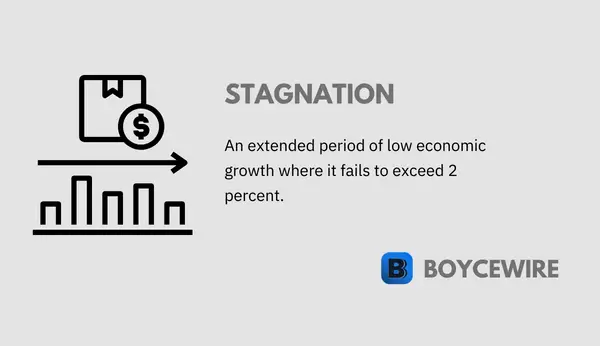Stagnation: Definition, Causes & Examples

What is Stagnation
In economics, stagnation is where a nation experiences an extended period of low economic growth. This occurs when real economic growth fails to exceed 2 percent.
Whilst there is no precise set of years to define stagnation, around 5 years of low economic growth can constitute stagnation within the economy. This would coincide with a growth phase in the business cycle.
Most economies will go through periods of strong growth and decline, which is in line with the business cycle. So if an economy doesn’t experience higher levels of growth, it is fair to assume it is facing stagnation.
Key Points
- Stagnation is where an economy faces a prolonged period of low economic growth, usually less than 2 percent.
- When a nation faces stagnation, it can cause economic issues such as high unemployment, low wage growth, and low levels of business investment and activity.
- Stagnation occurs when there is a period of weak growth, however, stagflation also includes where there are high levels of inflation at the same time.
Stagnation can mean that the economy faces a prolonged recession, but it may also never experience economic decline. This is because a constant growth rate of 0.5 percent would still constitute stagnation.
The term ‘stagnation’ itself comes from the term ‘stagnant’. This is defined by a lack of activity, growth or development. So when an economic is barely growing, it fits within this definition.
Causes of Stagnation
Stagnation tends to have various causes and varies from nation to nation. Those in the developed world will experience stagnation due to very different factors to those in the developing world. Whilst developed nations may face an ageing population, developing world nations suffer from political instability.
Stagnation occurs when there is little economic growth, so different nations can experience this is different ways. Developed nations may find it more difficult to achieve economic growth as they have reached somewhat of a ‘plateau’. However, developing nations have a much greater potential for growth. So the contributory factors will also differ.
With that said, let us look at some causes of stagnation below:
1. Lack of Business Confidence
When businesses lack confidence in the economy, they tend to restrict investment. This is because there is uncertainty about future demand. For example, a firm invests $10 million in additional capacity. This increases its ability to serve an extra 10,000 customers. However, if the firm is uncertain that demand will increase, then it won’t undertake that investment.
This might be due to a weak labor market or other economic factors. Yet when business lack confidence, they invest less. When there is less investment, there is less job growth. And when there is low job growth, incomes tend to decline thereby affecting consumer demand for those very goods its trying to sell.
2. Ageing Population
Ageing populations have put fiscal pressures on governments through pensions, healthcare, and absence from the workforce. First of all, governments have to find more money to pay for its ageing populations pensions. As time goes on, there are fewer people paying for more and more pensioners.
The World Banks ‘dependency ratio’, shows the ratio of dependents – those older than 64 – to those of a working age of 15-64. This ratio has increased rapidly since 2000, with large gains in France, Germany, and Italy, among others.
It has roughly increased from around 20 per 100 in 2000, to nearly 35 by 2020. So that means there was 4 people bringing in taxation per pensioner in 2000. But by 2020, this amounted to 3 people per pensioner. That would equate to roughly an extra 33 percent in increased taxation needed to support the elderly.
More importantly, those who retire are no longer in work. That means fewer people producing economic resources. So as the population ages, so too does its potential output.
3. Lack of Productivity Gains
One of the key drivers of economic growth is productivity. When a nation is able to produce more with the same number of inputs, it is more productive and can benefit economic growth.
For example, Germany might have 1 million workers that produce 10 million motor vehicles per year. If next year, it produces 12 million vehicles with the same number of workers and hours, it has become more productive. In terms of the wider economy, this boosts When there is a lack of productivity growth, it subsequently plays on the growth of the wider economy. Businesses are not able to become more efficient, thereby putting pressure on prices and profitability. This results in stagnation throughout the wider economy.
4. High Interest Rates
5. Capital Flight
Capital flight can occur due to a number of factors such as political uncertainty, economic performance, higher taxes, or currency manipulation. When investors move millions and billions out of the country, it can affect the exchange rate, business investment, tax receipts, and the wider economy.
If significant levels of capital flight occur, it could exasperate these affects. Exchange rates may collapse, making imports more expensive. Business investment may decline, thereby reducing potential productivity growth. And governments may bring in lower levels of tax, placing fiscal constraints on its spending.
Small levels of capital flight are unlikely to have any significant wider effects, but large swings can cause such disruption. When this disruption hits the economy, it may have a lasting effect, causing stagnation.
6. Poor Monetary Policy
When central banks print too much money, they stoke the economy with inflation. In turn, this inflation has to then be controlled through higher interest rates, which can bring an economy into recession.
At the same time, when central banks print too little money and the number of goods in the economy increases at a faster rate, it can lead to economic collapse. This is because the supply of money needs to equally represent the number of goods in the economy. In turn, this can result in deflation which can be difficult to shift if it becomes expected by consumers.
So poor monetary policy may have detrimental effects on a nations money supply. Consequently, stagnation may result if economic activity becomes affected.
7. Economic Shocks
There are a number of economic shocks which can cause stagnation. Among them are war and famine, high oil prices, pandemics, trade wars, financial crises. These alone can create a jolt to the economic system leaving a nation’s economy on the fall struggling to get up again.
For example, high oil prices can trigger what is known as ‘imported inflation’. This is where the price of a key import increases so much in price that it not only affects that product, but others that rely on it. So in the case of oil, it can affect gas and electric, petrol and gas, as well as the production of thousands of other goods and services that rely on it.
If managed poorly, these economic shocks can have a long term affect, leading to stagnation over an extended period of time.
Is Stagnation Bad?
Stagnation is not necessarily bad by itself. If an economy has full employment, little poverty, and a content population, then stagnation is not bad from that point of view. Yet when stagnation is accompanied with high levels of unemployment, it can put a strain onto people’s lives.
When determining whether stagnation is bad, it’s important to determine what we mean by ‘bad’. By definition, stagnation is bad for the economy as it’s not growth. However, in terms of the lives of a nation’s population, stagnation is not always bad. Often, it occurs in countries that have already developed substantially and therefore struggle to find further growth.
Stagnation isn’t bad by itself, but when accompanied with high unemployment or inflation, it can create economic hardship for millions.
Nations such as France, Germany, Italy, and Spain, among others, have found themselves in periods of stagnation. Yet economic stagnation itself does not mean the people’s lives are bad.
With that said, when accompanied with high unemployment, it can cause great distress to a nation’s population. This is because stagnation will do little to improve employment opportunities. When an economy is not growing, it’s not creating jobs – so people are left unemployed.
When people are unemployed for an extended period of time, they may lose their house, as well as feeling of self-worth. This can create a financial and mental strain on millions of people.
Stagnation Examples
Dot-Com Crash and Euro Introduction
The dot-com crash was the overvaluation of technology stocks between 1995-2000, which eventually crashed by 2002. This was driven by the development of the internet, with stock markets betting heavily on new fast-growing internet-based firms with ‘.com’ in their domain.
Many online firms were wiped out such as Pets.co., Webvan, 360Networks, Boo.com, and eToys. The result was significant levels of market chaos and recessions across the globe.
This crash largely coincided with the introduction of the Euro in 1999. After its introduction, it weakened significantly against other currencies. Yet by 2002 and in the aftermath of the dot-com crash, it saw its new currency strengthen. Hit by sharp technology losses, investors fled the US stock market to better investments – notably the Euro.
What the strengthening of the Euro did was make exports more expensive. This played a significant impact on European economies, particularly that of Germany that relies on export driven growth. In turn, many European economies faced stagnation in the subsequent years.
European Financial Crisis
Again, it seems that Europe is unable to escape from stagnation throughout the region. This time, as a result of the 2009-2012 sovereign debt crisis, driven by Portugal, Italy, Greece, and Spain. Also known as the ‘PIGS’, these countries had amassed significant levels of government debt of which they could not repay.
The issue was with the fact that these countries relied on international credit which dried up as a result of the 2008 financial crisis. Unable to fund its existing debt and with a large fiscal deficit, these countries had to rely on the European Central Bank (ECB) and International Monetary Fund (IMF) to bail them out.
As a result of this crisis, these nations fell into stagnation. Yet whilst Spain and Portugal have come through in relatively good shape, Italy and Greece continue to face economic stagnation.
Part of the reason for Italy and Greece’s continued stagnation is its huge debt. As a percentage of GDP, both rate among the top 5 highest in the world. This is exasperated by its government’s high expenditure and fiscal deficit.
Japan’s Lost Decade
During the 1990s, economic growth in Japan averaged 1.3 percent per year. This economic stagnation through the decade was largely driven by a collapse in its financial market.
In 1985, Japan joined the Plaza Accord. As part of this agreement with the US, Japan would strength its currency to bring the US dollar back down in value. However, the strong yen made Japan’s exports more expensive and led to a short-term economic shock.
In response to this shock, the government of Japan undertook a period of expansionary monetary and fiscal policy to provide the economy with a boost. However, the stimulus created huge credit and asset bubbles in the financial and real estate markets in Japan. Once the bubble burst in the late 1980s, Japan experienced a period of stagnation through the 1990s.
Gulf War
The Gulf War was an invasion of Kuwait led by Iraq under Saddam Hussein in August 1990. Saudi Arabia, which also borders both Iraq and Kuwait, was one of Kuwait’s largest defenders. It is estimated that Saudi Arabia and Kuwait both paid $32 billion during its combined war efforts – placing significant financial strain on the nations at the time.
In the aftermath of the war, Saudi Arabia faced a political crisis. Unemployment increased and the economy fell into stagnation. In the strongly religious Islamic nation of Saudi Arabia, it is important to acknowledge that the presence of US troops on its land had significant long-term effects. The population was not happy with this arrangement and the following economic stagnation led discontent with King Fahd.
Stagnation vs Stagflation
Stagnation occurs when a nation experiences an extended period of slow or weak economic growth. For example, Europe faces economic stagnation with many nations failing to exceed anything above 2 percent. Italy only exceeded that level of growth back in 2000.
By contrast, stagflation is a mix of stagnation AND inflation. The name itself is a mixture with ‘stag’ coming from stagnation. And ‘flation’ coming from inflation. So in essence, stagflation is a period of weak economic growth which is also accompanied with high levels of inflation.
Stagflation become prevalent during the 1970s and early 1980s in the aftermath of the 1973 OPEC crisis and loose monetary policy. Many countries got hit by high oil prices which affected inflation and the wider economy. Yet at the same time, loose monetary policy exasperated the issue further as inflation reached nearly 25 percent in countries such as the UK.
FAQs on Stagnation
Economic stagnation is where an economy consistently fails to grow in a meaningful way. This is usually characterised by a prolonged period of growth that’s less than 2 percent per year.
Some of the main causes of stagnation include:
– Lack of Business Confidence
– Ageing Population
– Lack of Productivity Gains
– High Interest Rates
– Capital Flight
– Poor Monetary Policy
– Economic Shocks
Some of the main effects of economic stagnation include:
– Decline in economic output
– Higher unemployment
– Low levels of job growth
– Decline in wage growth
– Decline in sales
About Paul
Paul Boyce is an economics editor with over 10 years experience in the industry. Currently working as a consultant within the financial services sector, Paul is the CEO and chief editor of BoyceWire. He has written publications for FEE, the Mises Institute, and many others.

Further Reading
 Capital Asset Pricing Model - The Capital Asset Pricing Model (CAPM) is a financial model used to estimate the expected return on an investment based…
Capital Asset Pricing Model - The Capital Asset Pricing Model (CAPM) is a financial model used to estimate the expected return on an investment based…  Enron Scandal - The Enron scandal refers to a major corporate fraud involving the energy company Enron Corporation, characterized by deceptive accounting practices…
Enron Scandal - The Enron scandal refers to a major corporate fraud involving the energy company Enron Corporation, characterized by deceptive accounting practices…  Current Ratio - The current ratio is a financial metric that measures a company's ability to meet its short-term liabilities with its short-term…
Current Ratio - The current ratio is a financial metric that measures a company's ability to meet its short-term liabilities with its short-term… 